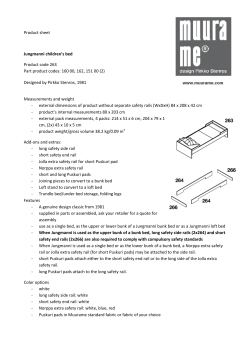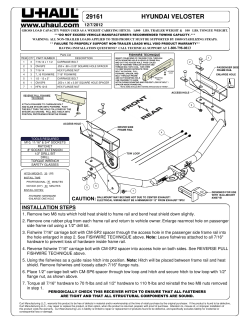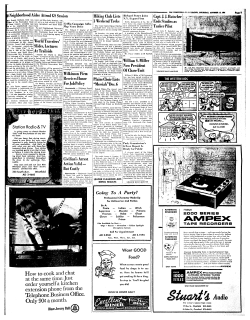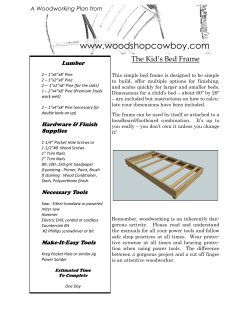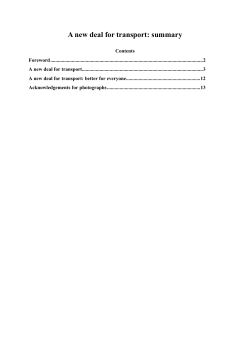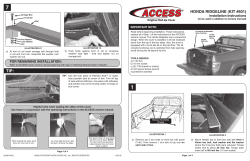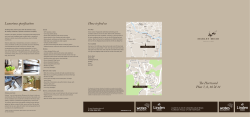
How To Triple Food Production By Developing High-Speed Rail International EIR
EIR International IBERO-AMERICA How To Triple Food Production By Developing High-Speed Rail by Dennis Small Usually, the mass media lie outright. Occasionally, they will report part of the truth, but out of context, so that no competent understanding of the dynamic involved will be accessible to the concerned observer. That is what the international media did with the stunningly successful July 2 operation executed by the Colombian military and government, which freed 15 high-profile hostages who, for years, had been held in jungle concentration camps by the narco-terrorist Colombian Revolutionary Armed Forces (FARC). The media presented the raid as a kind of Latino soap opera, focussing on the case of the suffering family of the courageous Ingrid Betancourt, a former Colombian Presidential candidate who endured grueling captivity for six years. But there are two additional features of the story of the freeing of the FARC’s hostages, which are essential to understanding its strategic significance, and which take us to the heart of our topic in this report: How to triple food production in Ibero-America. First, the July 2 success of the Colombian military and government was buttressed by cooperation from U.S. and French institutional forces, in which all the parties involved were shaped by three decades of activity and policy discussion—much of it working directly with Lyndon LaRouche and his associates in the region—on how to successfully combat international narco-terrorism. Second, on July 5, scarcely three days after the FARC raid, Colombian President Alvaro Uribe rode 26 International the wave of optimism sweeping his country, and all of South America, to announce that he was taking up the offer made months earlier by Venezuelan President Hugo Chávez, to jointly build railroad corridors between the two countries in order to promote their joint economic development. Those rail lines, Uribe added, should be extended south to Ecuador, Brazil, and across all of South America. Uribe’s initiative, in turn, led to a reactivation of the half-dormant Presidents’ Club—the informal association of the region’s heads of state—to again take up the issues of infrastructure development, and how to jointly create alternatives to the economic devastation that the current world system is wreaking on each of their countries. On July 11, Uribe and Chávez met in Venezuela and pressed forward on the railroad project. On July 18, Chávez joined Brazilian President Lula da Silva in a visit to Bolivia, where they offered a $600 million credit to finance the construction of a major bi-oceanic highway through Bolivia, which would eventually link up Brazil’s Atlantic coast with Chile’s and Peru’s Pacific ports. The next day, Lula flew to Colombia, where he signed significant cooperation deals with President Uribe, and the two were then joined by Peruvian President Alan García on July 20. And the diplomacy of development has continued into August. This feature of our story also goes back decades— and in fact centuries. For more than 25 years, LaEIR August 15, 2008 Transrapid A modern railway network, including Maglev trains, in Ibero-America will allow the Colombian-Venezuelan plains (a view of which is shown here) to begin to triple agricultural output in the region. These plains are equivalent in size to the combined area of the U.S. Great Plains states of Nebraska, Kansas, and Iowa! Rouche and his associates have presented detailed proposals for great infrastructure development projects for Ibero-America, which have been intensely studied and debated throughout the region. These included books, such as Industrial Argentina (1983) and Ibero-American Integration: 100 Million New Jobs by the Year 2000! (1986); countless studies and monographs; and a programmatic compendium presented by the LaRouche in 2004 Presidential campaign under the title The Sovereign States of the Americas: Great Infrastructure Projects (see EIR, Sept. 26, 2003). LaRouche’s approach to the development of the Americas, North and South, has always stood on the shoulders of the Good Neighbor policies of Franklin Delano Roosevelt, and of his policy predecessors, in turn, Abraham Lincoln and John Quincy Adams. In all of these cases, infrastructure development—and the building of railroads, in particular—played a very special role. August 15, 2008 EIR And so, when Colombian President Uribe followed the successful July 2 operation against the FARC, with a July 5 announcement of a plan to build continental rail lines, Lyndon LaRouche exclaimed on July 8: “Now we can replace narco-terrorists with farmers!” Maglev Railroads Here’s how. As the world financial system disintegrates in a hyperinflationary blowout, the planet today is teetering on the brink of widespread starvation. As Schiller Institute chairwoman Helga Zepp-LaRouche has insisted, the world can and must double food production in the short term, with national self-sufficiency in production in every sovereign nation-state. In the case of Ibero-America, basic grain production can be nearly tripled in a decade, if vast new areas of rich agricultural land in South America’s interior are opened up to development by the construction of a International 27 FIGURE 1 World Land-Bridge Bering Strait 1 3 4 5 6 2 Main rail lines Existing Proposed continental network of high-speed rail lines. This network would be an integral part of the 65,000-kilometer World Land-Bridge (Figure 1), whose Eurasian components are well on their way to completion. Arguably, the two most critical bottlenecks of the World Land-Bridge are the Bering Strait, which links Eurasia with North America, and the Darien Gap, between Central and South America. The Russian government is actively promoting the construction of a Bering Strait tunnel, and has even sponsored international conferences including U.S. representatives, which demonstrate the technical and economic feasibility of the project. This project has long been promoted by Lyndon LaRouche. The Darien Gap project—which would link up rail routes stretching through North and Central America, with South American corridors extending down to Argentina’s Tierra del Fuego—is almost as critical. Doing this involves crossing a 60-mile stretch of dense jungle 28 International 1 2 3 4 5 6 Bering Strait Darien Gap Sakhalin Bridge English Channel Strait of Gibraltar Suez Canal along the border between Panama and Colombia, which has never even had a highway built through it, let alone a railroad—despite the fact that detailed plans for the construction of a Pan American Railway, including the Darien Gap, were drawn up as far back as the administration of U.S. President William McKinley (1897-1901). The Darien Gap has been newly studied by the highly qualified American rail engineer Hal Cooper. In a paper prepared for delivery in October at an international conference in Turkey (an advance copy of which was made available to EIR), Cooper presents two distinct, viable routes for the project. “The Darien Gap railway connector would be approximately 85 to 95 miles (136 to 152 km) long and could go by either a central lowland route, parallel to the uncompleted Pan American Highway, or by an elevated hill and mountain route to the east of the Pan American highway,” Cooper proposes. The former EIR August 15, 2008 FIGURE 2 South America: Great Rail and Agricultural Projects Caracas Panamá Buama Caracas Darien Gap COLOMBIA-VENEZUELA PLAINS Bogotá Bogotá Bogotá Quito Quito Amazona Río s Leticia Saramirisa Santarém ra Paita Etén Belén i de Pucallpa Pucallpa a M o Porto Rí Velho Iñapari Callao Lima Lima ayo nc Hua Conete Puerto Maldonado Mataran Mollendo Cuiabá Desaguadero Desaguadero Santa Cruz Santiago Santiago Brasilia Santa Fé do Sul Arica Antofagasta Antofagasta Salvador CERRADO Asunción São Paulo Córdoba Montevideo Buenos Aires Grandes obras hidráulicas Ríos navegables Grandes obras Canales propuestos Grandes obras ferroviarias ferroviarias Main rail lines es Existentes Zona productiva industrial de mayor Existing dianoa plazo densidad Propuestas mediano plazo Proposed Propuestas Propuestas a a corto corto plazo plazo Zona Zona productiva productiva industrial industrial de demayor mayor densidad densidad August 15, 2008 EIR International 29 route would run “through thick tropical rain forests in parallel to the Chucunaque and Tuira Rivers where heavy rainfall, thick jungles, insects and snakes, plus frequent flooding, would be major problems over much of the year. . . . The alternative eastern mountain route would go over the Serranía del Darién Mountains to the Atlantic drainage side over relatively gentle grades through rolling hills with maximum elevations of 1,500 to 2,000 feet (455 to 610 meters) through heavy tropical forests.” “A significant challenge would be involved no matter what routes were chosen,” Cooper notes. “The western lowlands route would be shorter in length, but would go through flood prone areas with heavy rainfall, and would have to be built through a national park. The eastern highland route would be longer, but would be able to avoid much of the flood prone areas and would probably not need any tunnels, and would not have to be built on an elevated course way.” In Figure 2, we present EIR’s proposed routes for the South American portion of the World Land-Bridge, including both the small number of existing rail lines, as well as new lines to be built. These will be highspeed, standard-gauge rail lines, that will be doubletracked for most of the route. They will have to be entirely electrified, and/or magnetic levitation lines, which will, in turn, require a major increase in the availability of power—which can only come from the large-scale development of nuclear energy. Once the rail line has crossed the Darien Gap into Colombia, it will branch into three, major North-South continental corridors. The Western Corridor will run south from Bogotá through Ecuador, Peru, Bolivia, Paraguay, and into Argentina. This route will run along the eastern foothills of the Andes Mountains, laying the basis for opening up the entire undeveloped interior of the continent, which runs from the Andes to the Atlantic coast. A second major route, the Central Corridor will run southeast from Bogotá, to Leticia, and from there will cut across the Amazon jungle to Pôrto Velho, Cuiabá, and São Paulo in Brazil. A third, Eastern Corridor will hug the Atlantic coast and run from Colombia to Venezuela, Guyana, Surinam, French Guiana, Brazil, Uruguay, and Ecuador. Various East-West corridors will also be built from the Western Corridor to cross the Andes and reach the Pacific coast. One of the more promising is Saramirisa 30 International in Peru, where the Andes reach their lowest elevation, 2,500 meters (8,200 feet) above sea level. Other crossAndes spurs will link Argentina and Bolivia up with a Coastal Corridor running the length of Chile. These are essential to transform an integrated South America into a two-ocean economic power—much in the same way that Abraham Lincoln’s transcontinental rail project achieved that objective for the United States in the second half of the 19th Century. Food from the Plains and the Cerrado It was Lincoln’s railroads that also allowed for the transformation of the U.S. Great Plains states west of the Mississippi River, into the agricultural powerhouse that they became. That same principal applies, 150 years later, to the heartland of South America. There are two, principal areas of underutilized cultivatable land in South America where a vast increase in food production can be readily achieved: the Colombian-Venezuelan Plains, and Brazil’s Cerrado (see Figure 2). The Amazon jungle lies between them. The Colombian-Venezuelan plains are a continuous stretch of some 50 million hectares (212,000 square miles) in the Orinoco River basin. There is significant annual rainfall—in fact, too much in certain seasons—and there are major rivers which cross the region, including the Meta and the Guaviare. The land, once treated with lime (between 3 and 5 tons per hectare) to address the problem of acidity, is wellsuited for extensive agriculture. Today, it is vastly underpopulated, underdeveloped, and largely controlled by London-promoted drug-trafficking armies. For example, the Colombian portion of the region (about 60% of the total for the two countries), constitutes 27% of Colombia’s national territory, but has only 3% of its total population—some 1.5 million inhabitants. There are few roads in the region, and no railroads. In size, the Colombian-Venezuelan Plains are equivalent to the combined area of the U.S. Great Plains states of Nebraska, Kansas, and Iowa. (This critical region is further discussed in Maximiliano Londoño’s article below.) Next, turn to the huge Cerrado region of Brazil, which is nearly four times larger than the Colombian portion. Its 205 million hectares (792,000 square miles) are equivalent to the three mentioned U.S. states, plus North Dakota, South Dakota, Missouri, Oklahoma, and Texas. Parts of the Cerrado are a bit more develEIR August 15, 2008 TABLE 1 Ibero-America’s Great Agricultural Projects: Grain Production Total Land Area (Million Hectares) Area Cultivated (Million Hectares) Ibero-America today 2,058 51 —Production —Imports —Consumption —Consumption, no hunger —Consumption, 2018 Colombia-Venezuela Plains 50 15 Cerrado 205 50 Mexico, NAWAPA-Plus 196 5 Sub-Total, 3 Projects 70 Total, Today + 3 Projects —New Total as % of Today Production (Million Tons) 160 40 200 260 350 60 210 20 290 450 281% Source: FAO, EIR. oped than the Colombian-Venezuelan Plains, but this is largely by the international grain cartels, which exploit huge tracts of soy beans, and process them almost entirely for export. The Cerrado is a vast tropical savannah, a wellwatered grassland, which constitutes 24% of Brazil’s total land area of 846 million hectares—which, in turn, is 9% larger than the continental United States. Three main river systems drain the region: the Araguaia-Tocantins (into the Amazon basin); the Paraná (southward to the Río de la Plata basin); and the San Francisco (to the Atlantic Ocean). Like the ColombiaVenezuela Plains, with the right fertilizer and lime applications to the soils, the region’s agro-climatic potential is vast. The temperature regime for much of the Cerrado will permit two, and sometimes three crops a year. As we indicate in Table 1, some 50 million hectares out of the Cerrado’s total of 205 million can be put under crop cultivation. This will produce about 210 million tons of grain per year. Similarly, in the Colombian-Venezuelan Plains, grain can be grown on some 15 million of its 50 million hectares, producing about 60 million tons. If we add in the significant increase of irrigated land—and thereby food output—that can be achieved in Mexico with the implementation of the combined August 15, 2008 EIR NAWAPA, PLHINO, and PLHIGON water projects (see “U.S. and Mexico: Cooperate On Great Water Projects,” EIR, Dec. 7, 2007), a total of 290 million tons of additional grain can be produced in IberoAmerica. This will make for a near tripling of the current, inadequate output of 160 million tons of grain per year. Even if we factor in: a) replacing current imports (40 million tons) with regional production; b) bringing food consumption levels up to the point where hunger is eliminated for the 40-50% of the population today suffering from hunger (another 60 million tons); and c) providing for a 3% yearly population growth over the decade that it will take to bring these major projects on line (90 million additional tons); the total required grain production of 350 million tons by 2018 will be more than matched by the 450 million tons that will be produced. Regional food self-sufficiency is unquestionably an achievable goal. But: To achieve this, it is absolutely necessary to build high-speed rail corridors to bring capital inputs into the agricultural regions, to transport the product to market, and to provide the overall infrastructural backbone for the industrial development of the interior of the continent. South America must do today, what the United States did in the 19th Century under Lincoln. And it will be able to do so in cooperation with a United States which has returned to the policy orientation of Franklin Delano Roosevelt, as the policies of Lyndon LaRouche represent today. The outlook required is that of the Peruvian patriot Manuel Pardo, who as President from 1872-1876, in alliance with Abraham Lincoln’s networks in the United States, launched a major national railway project which included crossing the Andes. Their enemies sarcastically dubbed it “the Train to the Moon.” But Pardo already knew, in 1860, the enormous role to be played by railroad infrastructure: “Join the three central lines by means of the fourth, and decide if, in ten years, a revolution will not have occurred in Peru, a revolution at once both physical and moral, because the locomotive—which, like magic, changes the face of the country through which it passes—also civilizes. And that is perhaps its main advantage: populations are put into contact. It does more than civilize; it educates. All the primary schools of Peru could not teach in a century, what the locomotive could teach them in ten years.” International 31
© Copyright 2025


